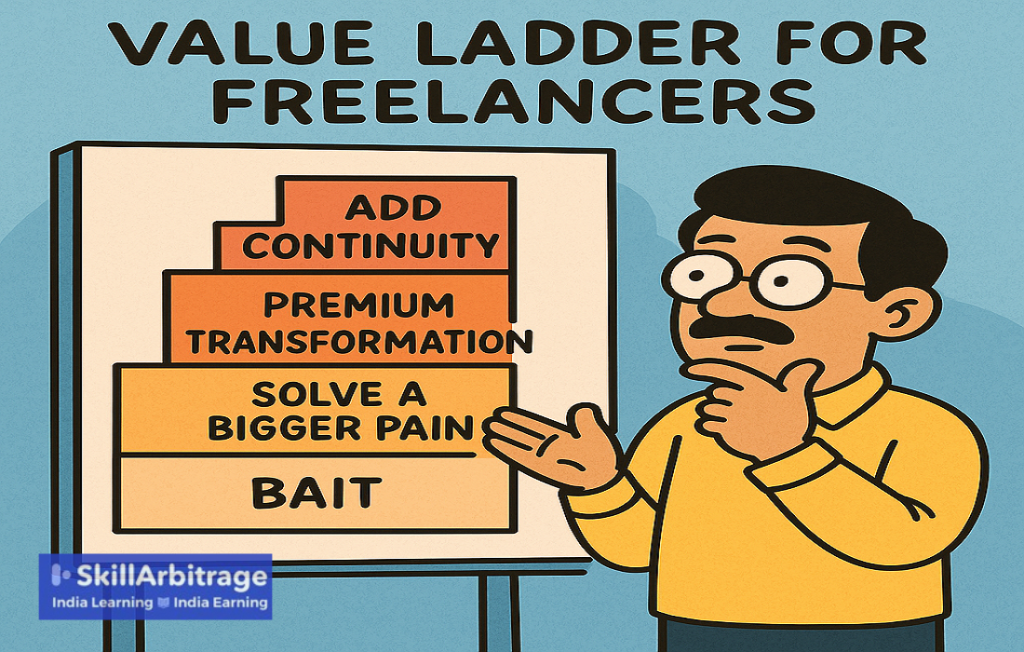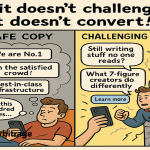Most Indian freelancers hustle hard to land one-off projects, only to end up stuck on the client treadmill, chasing new work every month. This article shows you how to escape that grind using Russell Brunson’s Value Ladder strategy.
Table of Contents
Previously on 4 Questions…
Swathi helped Raja, Savitha, and Harsh cut the clutter with four sharp questions. The goal was to stop chasing random gigs and start doing more meaningful work for clients they actually liked.
In this one, Raghunandan finds them idle again and hits them with a hard truth: they never built a value ladder. Through a mix of banter and blunt lessons, he shows them how to turn one-off wins into a stacked and scalable business, one rung at a time.
(Continued…)
When Raghunandan stepped into the apartment, he expected the usual chaos with whiteboard scribbles, delivery chai cups, and a Harsh rant about open rates.
Instead, he found a crime scene of burnout and boredom.
Savitha was sprawled on the sofa, phone held above her face, scrolling aimlessly.
Raja lay flat on the tiled floor, arms crossed behind his head, eyes fixed on the ceiling fan like it owed him money.
Harsh had sunk into the beanbag, glasses askew, softly snoring. His laptop was still open, showing a half-drafted email titled “7 Mistakes Even Smart SaaS Founders Make.”
Raghunandan blinked.
“I thought you three were swamped with client work?”
Savitha didn’t move. “We were. Swathi made us do that four-question drill. Dream clients. Where they hang out. Bait. Results.”
Raja added, “We picked our niche. Made great bait. Closed some good clients. Gave them wins.”
Harsh stirred. “Best month of my life, open-rate-wise.”
Raghunandan looked around. “So what happened?”
“The projects ended,” Savitha said flatly. “That’s what happened.”
“One-time gigs,” Raja muttered. “Land it. Deliver. Done. Back to square one.”
It wasn’t that they lacked skill. Or strategy.
They’d cracked the client equation every Indian freelancer is told to chase: pick a niche, market smartly, show proof, get paid.
But now they were living the nightmare no one warns you about:
No matter how good your bait is, if your business has no depth, you run out of ocean fast.
Raghunandan made a facepalm motion.
“You didn’t build a value ladder, did you?”
They looked at each other, then back at him.
“A what now?”
Raghunandan pulled a chair, spun it around, and sat down like he was about to explain gravity to three flat-earthers.
“It’s like this,” he said. “You gave them a starter and stopped there. That’s like giving someone a taste of biryani, then snatching the plate away before they ask for more. They were ready to buy more. You just didn’t offer it.”
He reached for a napkin and started sketching with a pen.
“Here’s what you should have done. You start at the bottom with something cheap, fast, and useful. That’s bait. But from there, you guide them up. Solve a bigger problem. Then an even bigger one. Then offer something that changes their entire business or life. That’s the top of the ladder.”
He tapped the napkin.
“You’re not selling services. You’re engineering progression. A step-by-step path from tiny win to transformation.”
Savitha leaned forward. “So it’s not just one brilliant offer?”
“No,” he said. “It’s a journey. And if you don’t show them the next step, they’ll assume there isn’t one.”
Section 1: Solve a bigger pain
Harsh rubbed his temples, processing the shift. “So, the teardown should’ve led into a full retention game plan. Something that showed them the whole strategy. Not just a snapshot of what could be done.”
Savitha nodded, eyes widening. “Right. They liked my audit, but I should’ve sold them an entire story-driven shoot that digs deeper into their brand’s essence, not just a quick fix.”
Raja stood up, pacing. “One scissor statement isn’t enough. I should’ve led them into a full category sprint, really diving into their market’s structure, building the foundation for their next big move. A single statement can’t change their game. They need a complete reimagining.”
Raghunandan patted him on the back with a knowing smile. “You gave them one smart idea. Then you vanished. No wonder they didn’t call back.”
They all sat back, processing the impact of what he had said. The pieces were coming together.
Raghunandan leaned in, drawing a quick line under the “Bait” section of the napkin. Then he circled it and wrote, “The First Offer.”
He continued, “The goal of your first offer is to build trust, show them you understand their problem, and deliver something useful. But then what? The value ladder doesn’t stop at a single piece of bait.”
He pointed to the next line. “This is where you solve a bigger pain. The problem they didn’t even know existed until you showed them. Something deeper that’s a natural progression from the first step. This is your mid-ticket offer.”
Savitha raised her hand like a student in class. “So, instead of leaving them hanging after the audit, I could’ve offered to help them transform their brand story in a comprehensive way, turning it into a full-scale content strategy?”
“Exactly,” Raghunandan replied. “When you show them you’ve got more to offer, they’ll naturally want the next step. You’re not just showing them ‘a fix.’ You’re showing them ‘the future.’”
Raja leaned back, now deep in thought. “So after the teaser, I should’ve presented them with a whole blueprint for redesigning their market position?”
“Yup. You’re not selling them just a scissor statement. You’re selling them a market category transformation. The statement is just a stepping stone to something bigger.”
Harsh, always quick on the uptake, grinned. “So I should’ve pitched a full, long-term retention strategy, not just a quick one-off?”
“That’s it,” Raghunandan said. “Once they trust you with that first taste, you can offer them a larger solution that not only solves the next problem but also builds deeper loyalty. The key is making that transition seamless.”
He smiled, sitting back in her chair. “See, you weren’t just supposed to stop at the small win. You need to show them the next step. You’ve got the tools. They just need to see how it all fits together.”
Raja, Savitha, and Harsh looked at each other, the realization settling in. This was no longer about a quick win. It was about progression.
Freelancer prompt:
→ What’s the next-level result your ideal client wants after your first offer?
Section 2: Premium transformation
Raghunandan took a deep breath and pointed to the next rung on the ladder. “This is where most freelancers chicken out.”
They looked up.
“This,” he said, tapping the paper, “is where you pitch the big shift. Identity-level change. Expensive because it’s rare and valuable. This is your flagship offer.”
Harsh blinked. “You mean… I could’ve pitched my done-for-you activation flows? Full builds, full automation. Easily ₹2L+, if not more.”
Raghunandan didn’t blink. “That’s exactly what I mean.”
Harsh slumped back into the beanbag, eyes wide. “I’ve been giving away the thinking behind that in my teardown. Never thought they’d actually pay me to do the whole thing.”
“They would,” Raghunandan said. “Because now they trust you. But you never made the leap.”
Savitha looked stunned. “I kept telling myself these founders just wanted quick help. But they kept asking if I knew someone who could handle their content end-to-end.”
Raghunandan nodded. “They didn’t want a freelancer. They wanted a department.”
Savitha put her hand over her mouth. “I had the solution. A content marketing team in a box. Calendar, copy, shoots, strategy. I just never packaged it.”
“You weren’t lazy,” Raghunandan said. “You were thinking too small.”
Raja had been quiet all this while. Now he spoke. “I’ve been helping challenger brands reframe their entire positioning. Helping them collapse categories. Build pricing power. One brand even doubled revenue after we clarified their core story.”
He looked up, bitterly amused. “And I let them pay me like I was their freelance deck monkey.”
Raghunandan didn’t laugh. “That’s on you. You’re sitting on a ₹5L offer, Raja. You’re not being humble. You’re being forgettable.”
The room went quiet.
Then Raghunandan broke the silence. “You all have a flagship offer in your head. You just haven’t had the guts to sell it.”
Raghunandan nodded. “And it’s not even about them. It’s about you realizing that you’re not here to sell your time. You’re here to deliver a transformation.”
He drew a thick line under this part of the napkin.
“Premium doesn’t mean ‘fancy’,” he said. “It means rare. Hard to find. Impossible to ignore.”
Freelancer prompt:
→ What’s the ultimate result only you can help deliver at scale?
Section 3: Add continuity
Raghunandan added one last rung to the ladder.
“This is where the game changes.”
Harsh raised an eyebrow. “Another offer?”
“No,” Raghunandan said. “Insurance.”
They looked confused.
“You all keep doing great work. Then, sitting around wondering where the next project will come from. That’s because you built stairs with no floor. You’re always one project away from panic.”
Savitha groaned. “Don’t remind me.”
Harsh rubbed his eyes. “My teardown got me five clients last month. All done. All gone.”
Raghunandan tapped the napkin. “That’s why you need continuity. Offers that keep clients close. So you’re not begging for work in between projects.”
Harsh’s eyes lit up. “Wait. What if I created an ‘Inbox VIP’ offer? Like, a monthly advisory? Quick-strike audits. Ongoing suggestions.”
“Exactly,” said Raghunandan. “You become their inbox guy. Not their one-time teardown guy.”
Savitha sat up straighter. “I could run weekly reels and campaign plans. Keep their content engine alive.”
“Now you’re thinking like a consultant,” Raghunandan said.
Raja was already scribbling something on the back of a coaster. “A private founder club. I’ll run their narrative in real-time. Strategy, scripts, storylines. One message a week. Hand-held, high-touch.”
“Retainers aren’t for lazy people,” Raghunandan said. “They’re for freelancers who don’t want to die poor.”
They all turned to look at him.
“What?” He shrugged. “I’ve been saying this for months.”
Raghunandan drew a circle around the top of the ladder.
“This is what separates brand partners from project chasers. Continuity makes your revenue predictable. It keeps clients from drifting.”
Harsh nodded. “And keeps us from losing our minds.”
Raghunandan smiled. “Exactly.”
Freelancer prompt:
→ What could you offer monthly that makes clients want to stay close?
Raghunandan stood up and clapped his hands once.
“Alright. Enough startup depression chic. Raja, fold that blanket. Harsh, wipe that drool off the beanbag. Savitha, this isn’t a runway. Get up.”
They groaned but obeyed. Slowly.
He pointed to the whiteboard on the wall.
“You’ve all got clients. People who paid you, liked you, trusted you. And then you left them at the base of the mountain.”
“So what do we do now?” Harsh asked.
“You climb back up. You go to each one of those clients and say, Here’s the next rung. Want to keep going?”
Savitha raised an eyebrow. “And if they say no?”
Raghunandan shrugged.
“Then at least you built a ladder. Not a one-time stunt.”
He picked up the marker, drew a quick sketch of four steps, and underlined the top one.
“Your work isn’t done when they say yes. It’s done when they stop needing you.”
Clients don’t vanish. They pause. A value ladder tells them where to step next.
(To be continued…)







 Allow notifications
Allow notifications
